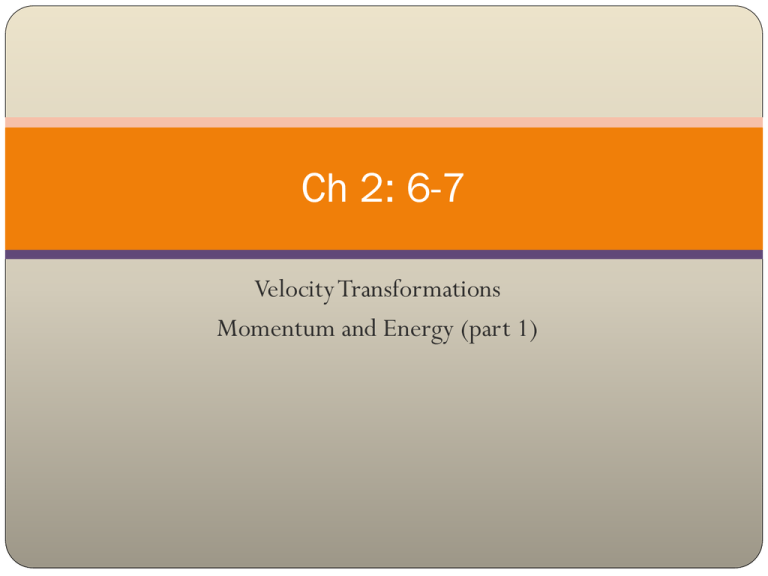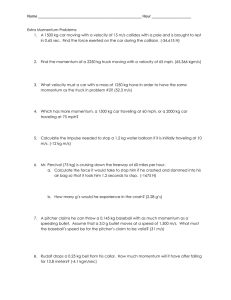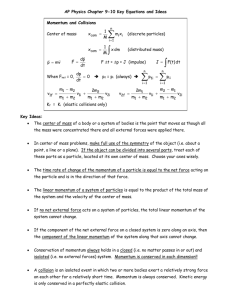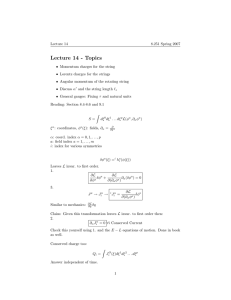Ch 2: 6-7 Velocity Transformations Momentum and Energy (part 1)
advertisement

Ch 2: 6-7 Velocity Transformations Momentum and Energy (part 1) Velocity Transformation for an object moving along x axis. Galilean Lorentz (Memorize) 𝑢𝑢′ = 𝑢𝑢 − 𝑣𝑣 𝑢𝑢′ 𝑢𝑢 = 𝑢𝑢 ′ + 𝑣𝑣 = 𝑢𝑢 = 𝑢𝑢−𝑣𝑣 𝑢𝑢𝑢𝑢 1− 2 𝑐𝑐 𝑢𝑢′ +𝑣𝑣 𝑢𝑢′ 𝑣𝑣 1+ 2 𝑐𝑐 Example 2.7 (page 32) A spaceship is traveling away from Earth at 0.8c. Further out a meteor is traveling toward Earth at 0.6c. Both velocities are according to an observer on Earth. According to an observer on the spaceship, what is the velocity of the meteor? Lorentz Velocity Transformations for an object moving along x and for (y or z) axis Perpendicular (MEMORIZE) 𝑢𝑢⊥ 𝑢𝑢𝑢⊥ = 𝑢𝑢 𝑣𝑣 𝛾𝛾 1− 𝑥𝑥2 𝑐𝑐 Along x (same as before) 𝑢𝑢𝑥𝑥 −𝑣𝑣 𝑢𝑢𝑢𝑥𝑥 = 𝑢𝑢𝑥𝑥𝑣𝑣 1− 2 𝑐𝑐 Ch 2: 59, 65 Let’s discuss 59b (in a few minutes) Due Tuesday 15SEP15 (Ch 2: 53, 59, 65) DON’T forget 53! Momentum Example 2.8 illustrates that if we use the classical expression for momentum (p = mu) we find momentum is not conserved in two frames (a violation of Einstein's first postulate). “momentum conserved” Instead, we have 𝑝𝑝⃑ = 𝛾𝛾𝑢𝑢 𝑚𝑚𝑢𝑢 1 where 𝛾𝛾𝑢𝑢 ≡ 2 𝑢𝑢 1− 2 𝑐𝑐 When the speed is low (u << c), we get the familiar expression p = mu. −2.34c ≠ −2.38c so momentum not conserved ? Conservation of Momentum 1. Start with the 1. ∑ 𝛾𝛾𝑢𝑢 ′ 𝑚𝑚𝑢𝑢 ′ = 𝛾𝛾 ∑ 𝛾𝛾𝑢𝑢 𝑚𝑚𝑚𝑚 − 𝑣𝑣𝑣𝑣 ∑ 𝛾𝛾𝑢𝑢 𝑚𝑚 relativistic expression 𝑃𝑃𝑃𝑡𝑡𝑡𝑡𝑡𝑡𝑡𝑡𝑡𝑡 = 𝛾𝛾𝑃𝑃𝑡𝑡𝑡𝑡𝑡𝑡𝑡𝑡𝑡𝑡 − 𝑣𝑣𝑣𝑣 � 𝛾𝛾𝑢𝑢 𝑚𝑚 for momentum. Then transform to unprimed I’ve dropped the frame. “v” subscript 2. Find an extra term, and identify this as proportional to total energy E. 2. 𝐸𝐸 ≡ 𝛾𝛾𝑢𝑢 𝑚𝑚𝑐𝑐 2 See also ugly math handout. I also dropped the “i” index subscripts Energy E is total energy, which includes kinetic energy as well as internal energy. E is conserved. If an object is stationary, it still has energy. “Rest energy” So kinetic energy (associated with motion) is total energy – rest energy 𝐸𝐸 = 𝛾𝛾𝑢𝑢 𝑚𝑚𝑐𝑐 2 where 𝛾𝛾𝑢𝑢 ≡ 1 𝑢𝑢2 1− 2 𝑐𝑐 If u = 0, 𝛾𝛾𝑢𝑢 = 1, and Einternal =mC2 K = E - Einternal K = (γu − 1)mC2 Section 8001 Stopped here. At low speeds, we get the familiar expressions for momentum and KE Section 0001 stopped here As v → c, all three diverge. C is the speed limit. Energy and Momentum Formulae to memorize 𝑝𝑝⃑ = 𝛾𝛾𝑢𝑢 𝑚𝑚𝑢𝑢 Total :𝐸𝐸 = 𝛾𝛾𝑢𝑢 𝑚𝑚𝑐𝑐 2 where 𝛾𝛾𝑢𝑢 ≡ Know that KE = TE − IE Also E2 = p2c2 +m2c4 (handout) 1 𝑢𝑢2 1− 2 𝑐𝑐 Section 9001 Stopped here. Example 2.10 (page 40) Object 1 of mass 9m0 and heading east at 0.8c collides with object 2 of mass 12m0 and moving west at 0.6c. The two stick together. Find the speed and mass (in terms of m0) of the resulting combination. Ch 2: 85 HINT: Example 2.9 (page39) Due Tuesday 22SEP15 (Ch 2: 85, 91 and 99) There is still one more to come! Example 2.11 (page 41) The nucleus of a Be atom has a mass of 8.003111 u, where u is an atomic mass unit: 1.66 × 10-27 kg. The nucleus is known to spontaneously fission into 2 identical pieces, each of mass 4.001506 u. Assuming the nucleus is initially at rest, at what speed will the fission fragments move, and how much KE (in J and keV) is released? (1 eV = 1.602 × 10-19 J) From Example 2.10, we learned that ∆K = −∆mc2 Ch 2: 91 Due Tuesday 22SEP15 (Ch 2: 85, 91 and 99) Total of 5 problems (90 points) Follow guidelines on the CPS. Start with basic (memorized) equations from book or notes. Identify equations Explain all steps Be neat, organized, clear and complete.









